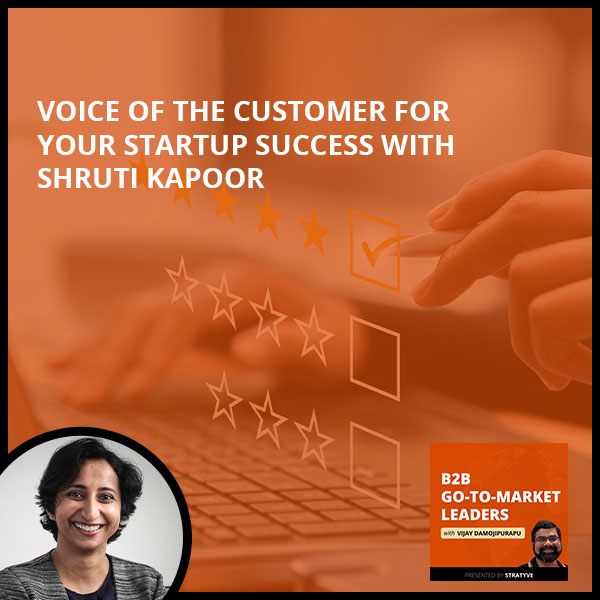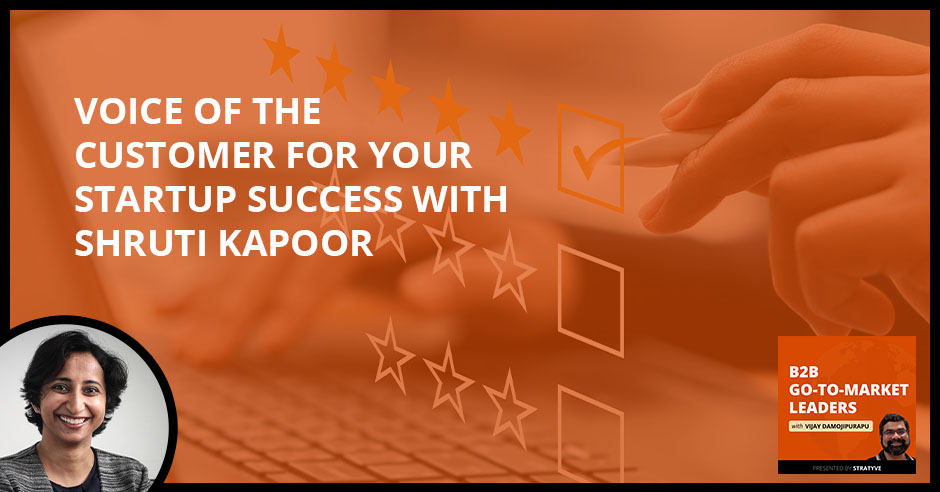

End-users are the best source of feedback on a product you are launching. Giving value to the voice of the customer can help you realize opportunities and provide the best solution. In this episode, Shruti Kapoor, the GM and Founder of Wingman, talks about how validation and differentiation play into making your solution stand out and ensure that your platform doesn’t only analyze data but ultimately affects change or improvement in an organization. Get tips on how you can build a level of trust and leverage your customers’ feedback in getting your business to scale. Also, get insights on when and how to connect to Y Combinator and set yourself up for success.
Sales in the times of an economic downturn.
—
Listen to the podcast here
Voice Of The Customer For Your Startup Success With Shruti Kapoor
It’s been a good several months since the last episode was released, but my commitment from now on is to be consistent. That’s my promise to my readers. It’s not just you but for my selfish reasons, I look forward to and enjoy speaking with the go-to-market leaders. In this episode, I have the pleasure of speaking with Shruti Kapoor, who is the Founder and CEO of Wingman. It’s Wingman by Clari because of the acquisition. We’ll go into a lot of other details, but I’m super excited to be speaking with you, Shruti. Welcome to the show.
Thanks, Vijay. Let’s get this season started with a bang. It sounds like this is the first one of the season.
I’m curious. What led you to go and live or work in Dubai? I believe you grew up in India. Is that right?
That is true. Yes and no. I did spend the majority of my life in India, but I spent a decade in Singapore somewhere in between. I moved to Dubai in 2022. In many ways, I’m enjoying the change. Being in a new place makes you relook at everything with a new lens. The business reason for this was as part of the acquisition, I wanted to be in some sense closer to the broader action. Given the constraints with visas, there are not as many countries as Indians that you can quickly relocate to. This seemed like a good fit from a time zone perspective, access to Europe and generally, very well connected. Here I am.
Especially the time zone and the access. You talked about the visa situations and all that. I’m glad that you relocated. You look to be that person who always looks for change and to be out of your comfort zone. You mentioned growing up in Singapore and India and relocating to Dubai. I’m super excited about that. With that, I want to transition a bit over here and then go into more of the first question, what I typically ask of my guests, which is how do you define the go-to-market?
There are two things that a company needs to do, build something and then make sure somebody is using it. The t-shirt I’m wearing says, “Make something people want.” This is the Y Combinator motto. I think of go-to-market as anything that helps you get your product into the hands of users.
I would love to get into the story of the whole Y Combinator. I was looking at your About. It was nice and creative as to how you came about and told your story of how you found that pain point and your cofounders, and what made you get into Y Combinator and so on. Let’s get into that. That’s a good transition. It looks like you were leading the go-to-market and sales team. You ran into this problem with your product. Even marketing folks ask you, “Can you get customer feedback?” That was the genesis of this. Tell me more about the story. What did you and the team do to go down this path?
Before I started Wingman, I was working at a company called Payoneer, which by no means can be called a startup. They did an IPO in 2021 or so back. At the time when I was working with them, I was the third employee in India. They were trying to enter this new market. My role was to help them figure out their go-to market. The way the team was structured was there was a central team, which was doing marketing and product. They would have regional teams that were doing more customer-facing roles, partnerships, customer success, sales and a variety of other things that show up.
There's a lot of value in having the voice of the customer for teams outside of sales. Share on X
What that did was it made the distance that exists between customer-facing teams, marketing and product teams much more stock than it is in usual organizations. That gap always exists but in this case, it made it much more stock. We were launching this product into the new market for the first time. There was a lot of stuff that we needed to learn from what the customers were telling us and take back to the rest of the organization.
It wasn’t always easy. I’m sure all of us have had that experience where we tell the product team, “The customer said that,” but it goes in one ear and comes out the other. If they happen to be on a call with the customer, it has a very different impact. They’re suddenly like, “That’s why the customer wants it this way. Let’s see if we can prioritize this on the roadmap.” In that process, what we realized was there’s a lot of value in having that voice of the customer for teams outside of sales as well.
As a person who was on the sales side, everybody faces so you have folks in your team who are doing well and folks who are not doing well. Sometimes everybody seems to be putting in a lot of effort but getting very different results. You’re wondering what you can do to help them. That was my other challenge. Those two things came together. We were like, “Both of these problems can be solved if we could go back and analyze every call that happened between the customer and the salesperson. We could also get broader insights from it because nobody has the time to listen to every call recording.” That was how this started.
When you were doing this, you found that problem. You must have done some market research. Were there alternative solutions back then?
There were a couple of solutions that had started. In our space, two competitors have grown well, Chorus and Gong, which both also started at the time when we were doing our initial research. Maybe they had a year of a head start at that point. We saw that almost as validation. When we look at problems and you don’t find anybody else trying to solve them, it’s almost a question mark. “Is there something that I’m thinking is wrong?”
In this case, the feedback that we got very consistently early on was, “I’m not sure if my sales reps would be okay to record their calls. Forget about it. Even if my sales reps were okay, I’m not sure if my customers would be okay to record those calls.” Honestly, if you were in that ideation phase and five people told you that, you would be like, “That makes sense. That’s why nobody else is doing this.” Some competition is good.
You bring up a very good point, especially for startups. You’re paying with so much risk and many variables. You want that market to be validated. There’s a lot of talk about category creation and all of that but you don’t take that approach with the startup on day one versus the category creation coming later on. A good lesson insight for founders, current CEOs and aspiring founders is to make sure that there is some market validation. I have seen where people go down a path and burn their money, time, motivation, energy and the people in 1 to 2 years but nothing happens. Kudos to you and your team of cofounders to take that as a validation and a hypothesis that’s already been tested out. You don’t need to do that.
The other thing that I learned through that process of early market research was when you have a solution for any problem that you have, there is a way that somebody’s already trying to solve that problem. It doesn’t matter whether there’s a direct competitor or not. There is always competition of some sort. It’s important to find whatever that closest thing is. Go and figure out that even with that closest thing, what are the challenges that people still have?

Early on when you’re trying to make that initial product and do that minimum viable product, you say, “I have to do all of these things, which are going to give me parity with the existing solution. I have to build all these other things that are going to give me differentiation.” If you go and speak to users who are solving that problem with whatever is the closest competitor to your solution, you should go and spend time with those users. Not with the context of, “Will you switch to my solution?” It’s with the context of, “What can I build that will add value to this person without me having to build everything else that exists?” It’s a very easy pitfall that people make. You can easily delude yourself into building products for two years and not having a single dust to it.
It goes back to the whole Steve Blank and others who have promoted this, which is a lean startup philosophy that has done that from the early days, which is good. How did you go about finding the customers of Chorus and Gong and other alternatives?
It’s a little bit of serendipity and the fact that Silicon Valley is a bit of an eco-chamber. If there is a SaaS company and it’s based in the Valley, there’s a pretty good chance that their first hundred customers are also based in the Valley. If you speak to enough Valley companies, you’ll find somebody who’s heard of that company or using that company. That was broadly how it happened.
Switching gears here. With the problem, you found that there is market validation and a need based on this. The next step was you met with your cofounders, who are the CPO and the CTO. There is that problem-finding phase, market validation phase and, “How do you find my cofounders?” That’s key. Tell us and share your experience with the readers as to how you made that happen.
The order was a little bit different. I met my cofounders before we necessarily zeroed in on this idea. The way I met Murali, who’s the CPO, was through a common friend whom he went to college with in engineering and went to college with me in my MBA school. At that point, Murali was moving back to India. He was very clear that he wanted a startup. He had previously worked in a very early-stage startup that had gotten acquired by Google. He had seen that startup life and Google life. He knew where he wanted to spend his time. He moved back to India with the intention of starting up. That’s when we met.
At that point, I still have a full-time job. We started discussing and ideating. We went through multiple ideas before freezing on this one. Srikar and Murali have known each other for a long time, since their first jobs in 2005 in EntreLogy. Broadly speaking, every company probably has different founder-team stories. If somebody’s looking for that cofounder, unless you already have somebody who’s complimentary to your skills, spend time and effort in finding that person who is complementary to your skillset.
That can make a huge difference in how much you can accelerate and how lean you can stay. We were a founding team of three people. We had different specializations in some sense. We could afford to keep a relatively small team. There was so much tech and product work between Murali and Srikar that could cover. It helps to make sure that you stick to what you need to complement yourself and find that person.
Know your strengths, which is self-awareness and know your gaps as well. The key is to find that person who not only will cover your gaps but also from a chemistry and validation point of view, you all click. That’s key. Before we dive or go further into Wingman, your target audience and whom you serve, here’s one final question on the early days of your startup journey. How do you prep for the Y Combinator pitch? What advice would you give to people who are looking to apply for Y Combinator and other incubators?
When we look at problems and we don't find anybody else trying to solve them, it's a question of whether there is something wrong or what we’re thinking is completely wrong. Share on XYou should think about whether or not it’s going to help you, depending on where you are in your stage of the journey. At least with Y Combinator, our experience was that if you were at the point where you were either building that product, doing user research and figuring out what was your value proposition, it was a great, time and phase to be in Y Combinator. There is enough and more advice on what Y Combinator evaluates and how to go through that interview process.
I don’t think there is a real secret sauce. It’s just a lot of clarity in terms of saying, “This is the problem that the startup solves. Why has nobody else tried to solve it before? What does the competition look like? Why do we think we are going to succeed?” As we went through the process of preparing for the Y Combinator interview and the application process, we spend a lot of time answering these questions as three founders sitting in a room and going through them.
A lot of these things became clearer to us to the extent that I was like, “At this point, it doesn’t matter whether or not we get into Y Combinator.” The interview preparation process has helped us so much in thinking clearer and crystal. Some of these external things work as forcing functions. It’s important to make sure that you know the other questions that you need to answer first. It’s easy sometimes to go in the flow of the building, working and hustling, whereas you might not have figured out some of the basics.
I like the fact in how you phrased it, which is irrespective of the outcome of the result when you go through the whole Y Combinator application process. The very fact that the questions are the problem statements that the Y Combinator application is putting forward will force you as a team to realize where you are in the journey, whether this is the right thing and whether you are going in the right direction or not. Switching gears, let’s talk about Wingman. You serve the salespeople but with sales, you got different titles and roles. Whom do you serve? Why did they love Wingman?
One of our early insights as we were doing our market research was when I’m building a product for recording and analyzing sales calls, I can serve anybody. I could be serving product teams and helping them get user insights, for example. What we realized was that the first thing is the team that you choose to serve, your stakeholders, are the people who at least have the ability to influence the adoption of your platform. The natural thing for us was you can’t get this adopted unless the sales leader decides to get this adopted. Therefore, you better make sure that the sales leader is an important stakeholder in your product.
The second thing was we noticed that a lot of times people were looking at this and this happens with a lot of sales tools. It’s a legacy because of the way salesforce operates. No sales rep ever believes that salesforce helps them. They all believe that it helps their manager. They’re only spending time in salesforce because their manager needs them to. What was important to us was to say, “This should be a platform that doesn’t just serve the manager but the sales reps as well.”
Ultimately, it doesn’t matter how much insight the manager has like, “This is what happens in the calls at Wingman. These are the things that my reps are doing wrong.” At the end of the day, the reps have to be the people who are taking the action to correct those things. Unless they are the ones directly involved, you are creating additional loops. If those loops don’t close, then no action happens. For us, that was a very early insight so we were like, “We have to build a platform that directly helps the sales reps and ideally, helps the sales managers by making sure that the sales reps can help themselves.”
Going back more into the tactical and doubling down on this thing, how many user research calls you were doing a day or a week during this whole process?

We did it in maybe 2 or 3 batches. Before we started, we spoke to around 20 to 30 sales leaders who were more directly from our network to validate the problem and understand like, “What would you do? How would you use it?” This was before we wrote a single line of code. Once we started building the product, our priority was to make sure that we could have people who could use it and then give us feedback. That was the tinkering part. At that point, we did a bunch of interviews and maybe that was around 30 or so as well.
The third phase was that once we had figured out the product and we knew that we wanted to do real-time insights and this is what the meat of the product needs to look like, we then went and did two months. This coincided with our time at Y Combinator where we said we will go and speak to hot companies. Specifically, in our ICP, we’ll be very strict about whom we qualify. Three phases happened for us.
My peers in other startups and I struggle with this. We know the concepts of ICP. Defining the ICP, trying to reach out, doing the research and then getting feedback is a challenge. As an example, I can come up with an ICP of, “It has to be a company that has at least 5 employees or 1 location.” That’s a broad profile with multiple markets, industries and use cases. How did you narrow it down? You have a very limited amount of time. You’ve lined up all those people from a validation point of view but how did you lock that ICP?
It’s easy to get greedy and there is always that temptation. You’re trying to tell a bigger story to the market, the investors and everybody where you’re like, “This is a $20 billion market. Everybody in the world can use it.” It’s easy to go into that zone but very early on, make sure that you have something that is useful for somebody and you’re not building for two years, which essentially means that you have to find a small segment. Later on, you can expand your product and segment.
For us, there were a few things. One was we realized, “Is this generally a well-accepted technology?” The answer is no. “Does it influence user behavior?” Call recording is somewhat difficult for people to accept the first time. That’s true. Essentially what that means is you need early adopters. People who are early adopters in our case are specifically other tech companies. That’s broadly true for a lot of people.
The next thing was, “Do I sell to anybody who is in the tech space? Could it be a service provider or a product company?” That was the other distinction. The third distinction was, “What is the size of that sales team?” I could sell to a single founder or a 1,000-person sales team. “Where do I want to play?” What we realized was early on, there’s a sweet spot. We don’t want to build a self-serve product on day one. We want to be able to build a product that delivers more value than just recording calls and transcribing them.
There’s going to be some effort for adoption. That led to us saying, “It has to be at least a 10-member sales team that’s going to get the most value out of this.” With the product maturity, the time and energy that you want to spend on creating something very customizable, the settings and all of that, maybe you don’t want to work with a 1,000-member sales team on day 1. We then narrowed it down further and said, “Maybe it’s 10 to 50-member sales teams that we want to work with.” That was our process.
Thank you for sharing that amount of details. Your user is the salesperson. Maybe it is the BDR or the AE. The buyer is necessarily not them. It’s going to be the sales manager to whom the BDR or AE reports so you need to get both on your side.
The team you choose to serve your stakeholders has to be people who can influence the adoption of your platform. Share on X
From a sales process perspective, it’s a fairly top-down approach. We would engage with the head of sales or the sales manager. When it came to us selling our product, they would then do a top-down on telling their team to adopt it. The ICP has expanded and we work with larger companies. We have the ability to also segment out the complexity of the product and the features by saying, “I could have a very lightweight version for a single user team,” versus, “I can have fairly sophisticated features.” Early on, it’s important to keep that narrow.
You completed or covered the journey from founding to getting your initial set of customers, investing, fundraising and all of that. If we switch gears over here, you were at a point where you are making single-digit million dollar ARR when Clari acquired it but it’s still a big jump from your first 5, 10 and 15 customers to getting to that million ARR. What is your growth trajectory? How did you make those investments as a CEO, plus handling the whole go-to-market? What were you scaling? What are your growth channels? How did you go about doing that?
It was interesting because we were building a product for sales teams. I wanted to be as close to that sales process for as long as possible so that, 1) I was also the user of the product and, 2) I was getting a lot more direct feedback on how every customer or prospect was receiving the product. What that meant was that to a large extent, early on, I was the only salesperson, the only SDR. I was doing my outreaches, cold calls, demos and closing the deals.
We only hired a head of sales close to hitting the $1 million mark. What that allowed us to do was to learn very quickly and make sure that we were also users of the product or at least I was a close user of the product and the rest of the team was as well. How did we think about that investment? We made some mistakes along the way as everybody does. The first was we did try to, in some sense, outsource this early on. We worked with somebody who was going to be a fractional head of sales for us, even before we had the first salesperson. The idea was this person can go set up the playbook and the early meetings and then help us accelerate that process. As a founder, you have one million other things to also take care of.
Our biggest lesson there was that early on, the customers are not buying the product because they trust the brand. There isn’t a brand. The product is likely getting built after you’ve promised it to the customer so they also know that very likely there isn’t a product. The thing that they’re going to trust if they were to make a buying decision is you. Therefore as a founder, you have to be the face that they see. Once we learned that lesson, I then amped it up to say, “If I have to be the person that they trust, let me build my credibility around it.” I then invested a fair amount of time and energy in interacting with that ecosystem and getting to know other folks within sales.
We had zero networks to start with because I had never worked in the US. Ninety percent of our revenue comes from that market. It was essentially being very conscious about saying, “I am the face of the company. People need to be able to trust me. Part of building the brand for the company is also building the brand for me.” I was going through that process. That helped us because a large part of our revenue comes from inbound interest. The flywheel had to kickstart with us putting a lot of these things in place.
Can you double-click on that? You’re getting to the point where a bunch of questions were running in my head. Early days, it’s going to be outbound but at some point in time, that outbound cannot scale, especially with you doing the outbound for the most part. Somewhere along the line, you had to do content, G2, analyst sites and others. You need to broaden your brand presence and awareness. What were the investments you made in the different phrases? Paid would be one I would assume and then content but you need to drive traffic to the content both on paid and organic. What do the growth channel phases and investment look like for you back then?
Firstly, paid was not something we invested in or got a lot out of, at least for the first few years. I think of it as layers of cake. You have to think of it as what can help people build trust. You’re only building trust with me while I’m still trying to build the brand for the company. The second layer of it is once I have those first five customers, can I use them to help build trust with others? You’re not going to show up on the top of G2 when you have five customers but you can still get good testimonials from them and leverage them whether on your website, outreach messaging or working with them. Be very conscious about it to say, “I worked with you. If you like it, then can we use this for building trust?”

The third step was you multiply that. If you have 5 customers and hopefully, either through testimonials or references you’re able to get another 5 each, then that makes it 25. That’s a great number. You layer it to say, “Now that I have 25 customers, maybe it is the time to go and hit review sites and other channels.” It eventually also depends on the persona. Salespeople are much more likely to speak to other salespeople to get advice on, “How are you doing something?” A product or an engineering person is very likely to go and do their research on Google and use that to base decisions.
The peer recommendation factor within our industry is much higher. We knew that we had to invest much more in that. It wasn’t just review sites. We spend time and energy being part of communities and their forums, understanding what questions people ask and making sure that our customers could represent us on those forums and discussions. That was a big growth lever for us. All of this is free. It doesn’t cost you money to do this. It just requires you to be thoughtful.
Something interesting happened. One of my customers referred me to a podcast host and said, “I want you to speak to this person.” That triggered a whole set of positive activities of its own. I thought, “Maybe this is rather a good channel where I could get the voice of the brand heard by more people while still being scrappy and not spending a ton of money.” As it turned out with the pandemic hitting and everything, that first year I must have done some 30 podcast interviews with different hosts.
That was also a great time when people were figuring out what they could do in the remote world to stay connected. There was a lot of activity and we were lucky to be in the middle of it. You have to be very aware of where your user hang out so that you can go hang out with them and how you can amplify that trust factor.
You were asking all your customers, “Where do you hang out?” Was it that simple?
To some extent, yes. When you’re building a sales tool, it’s interesting because you’re a user of that product and the people that you’re speaking with are also salespeople so they’re your peers. In a non-COVID world, they’re happy to go grab a beer with you and exchange secrets. It’s about being at the same events and then finding out, “How would you learn that? How did you go hire that person?”
I love the fact that you were not investing blindly in paid. It was all organic and more driven out of curiosity. That’s the sense I’m getting. Curiosity and the sense of intent as to, “Let me learn more about my persona and the people I’m serving. They’re using my product but what else can I be doing and how else can I make sure that while I’m serving them, my brand and my product is getting amplified?”
People often underestimate listening. I’m not just saying this in a sales conversation but even in the broader market conversation. One of the things that I recommend every salesperson to do when they join my team is, “Go find ten social media sales influencers and follow them.” It doesn’t matter whether or not you go on a sales call but you need to know how they think, what language they use, what is troubling them and what is aggravating them.
Build a product that delivers more value than just being able to record calls and transcribe. Share on XWith social media, we have access to those things for free and unlimited. Sometimes, it’s too much. When people say, “How should I be using LinkedIn,” most advice is like, “Build your profile and brand. Post every day.” It’s much more important to post five thoughtful comments a day on other people’s posts than to post something of your own every day.
Coming back to staying curious and serving your person, which is a sales team and the sales managers, it looks like your team has come up with the economic downturn analysis. Do you want to share what that is? What drove you to that? How people can learn more about that?
This quest for me started at the time of COVID when the world seemed to be suddenly going toxic. One thing that I kept hearing from casual conversations that I was having with people on social media or online was, “We are not able to sell because everybody has frozen budgets.” I was like, “Does that hold true?” I got curious. I went and searched all of the call transcripts that we had or at Wingman to see how often is that coming up and whether that dramatically changed because of the pandemic.
What we realized was that it had changed but it hadn’t changed as dramatically. The biggest factor was getting deals to be lost. To our surprise, the biggest factor was timelines. What had happened was that suddenly everybody had this feeling of paralysis because they didn’t know what was going to come next. We’re in a shocking state. That was when we got curious about the data.
In 2022, we are going through a big tectonic shift in some sense. We decided to go back and look at the numbers in 2022’s context to see what happens if people are talking about the economic downturn and sales calls. What are some of the things that then impact win rates for deals? There are lots of interesting things there about what has changed about discussions on discounts, budgets, timelines and everything. One of the interesting things that we’ve learned is if people talk about ROI conversations, their win rates for deals increased by more than 30%. There are lots of nuggets like that. Maybe we should share it with the audience.
That’s key. When I work with my sales team over here in my current role, I’m seeing that they’re trying to find it difficult. The obvious question then comes, “What’s the ROI? Why should I buy or switch now versus not do anything?” Framing the conversation around the value but at the same time, showing clear ROI matters. This has been a great conversation, Shruti. Going more towards the closing stages, I got two questions for you. Who are maybe the top 1, 2 or 3 people that have influenced you and shaped you as a person and mentored you in your career growth and journey?
The biggest influencers as we grow up right early on are our parents. In my case, it’s my father’s fearlessness. He sent me to Singapore to study. I went there alone. In those days, it was probably a little bit more of a leap of faith because you couldn’t communicate as easily. There was no video calling. A call will cost you a bomb. That example showed me the value of being fearless and taking your chances. That’s made a huge difference.
Over the years, there have been many influences. One was a previous manager of mine. His name is Kiran. The one thing that he taught me was, “You don’t have to accept all corporate mumbo jumbo for what it is. You can always stop and question things.” That’s another important thing that we sometimes overlook. Overall, there are lots of books and media that I learned things from but the personal connection would be the main ones.

Switching to the last question here, if you were to go back in time and go back to day one of your go-to-market journeys, what advice would you give to your younger self?
First is always asking the question, “How am I building trust with this person? What is my best lever to build trust?” The second is don’t take what people say at face value. Observe their behavior rather than their words. Not out of maligned intentions but people often behave very differently from what they say or think they do.
Thank you so much for your time, Shruti. It’s been a wonderful conversation. It was enlightening and insightful. I’m sure all our readers will benefit from this. Wishing you at Wingman the very best for the future.
Thanks so much, Vijay. I had fun.
Important Links
About Shruti Kapoor
 I have worked across lifesciences research, investment banking, technology investing, commercialization, product development, fin-tech and sales enablement using AI(current). I enjoy working in the interface between technology solutions and business needs and have worked in leadership and business development roles. I am also a trained Life Coach through Erickson Coaching and would love to have a conversation with you if you are feeling lost about your career or relationships or life in general. Also, interested in consulting for innovation and technology scouting & adoption.
I have worked across lifesciences research, investment banking, technology investing, commercialization, product development, fin-tech and sales enablement using AI(current). I enjoy working in the interface between technology solutions and business needs and have worked in leadership and business development roles. I am also a trained Life Coach through Erickson Coaching and would love to have a conversation with you if you are feeling lost about your career or relationships or life in general. Also, interested in consulting for innovation and technology scouting & adoption.
Love the show? Subscribe, rate, review, and share! http://stratyve.com/
